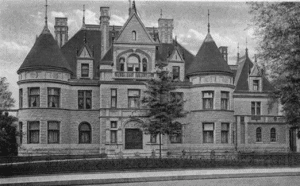Architecture as a Wesson family hobby
By Normand Corbin, Vice-Chairman, Northborough Historic District Commission

(Photo/submitted)
Part 4 of a series of articles on the history of the Daniel B. Wesson “White Cliffs” mansion in Northborough, Mass.
Northborough – Mr. Daniel B. Wesson is known to be involved with the construction of over 13 buildings during his lifetime. Considering he grew up in a humble home with 10 siblings in Worcester Massachusetts, it is interesting to see his interest in the building of large elaborate homes.
In 1876 he built a mansion in Worcester as a wedding gift for his daughter, Sarah. It still remains standing at 55 Pearl Street. The design is a High Victorian Gothic style with a granite exterior. The architect was the famous Calvert Vaux. Calvert Vaux is best known as the co-designer with Frederick Law Olmsted of New York’s Central Park. The building is listed in the National Register of Historic Places.
In 1898 Wesson built his new home in Springfield, Mass. in the French Chateau-inspired style. The architect was the famous Bruce Price. Mr. Price is noted for designing grand hotels for the Canadian Pacific Railway, including the Château Frontenac in Quebec City. Although it is a much grander construction than White Cliffs, which was built 10 years earlier, it had many similar architectural features. Sadly, the building burned down in 1966.
The design of unique homesteads by famous architects also carried over to Wesson’s sons, Walter and Frank. Walter’s home was built in Springfield and designed by Clarence Luce. It was built just a few years before White Cliffs and has many architectural similarities. Mr. Luce specialized in residential projects and is noted for being an early proponent of the Queen Anne style. Although listed in the National Register, this Springfield landmark has been demolished. Frank Wesson’s architectural firm was Robins and Oakman. His home remains standing in Springfield, Massachusetts and is listed in the National Register.
A big question remains concerning the White Cliffs mansion. Who was the architect of this gem? If you are able to help me solve this mystery, please contact me at [email protected].
Much of the information in this article was provided by the Massachusetts Historical Commission.














